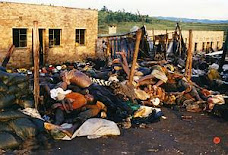Mugenzi: Yes, one of them had shown us pictures which showed what happened. You know, how the RPF came and prepared and shot those people. And those pictures had never been shown publicly before.
KPFA: And now, after that, the BBC reported that President Kagame, Rwanda's President Kagame, had sent assassins into London to kill you and your friend Jonathan Musonera.
Mugenzi: Yes.
KPFA: And have you been threatened since?
Mugenzi: We haven't because the UK government has warned the Rwandan government not to try to do those terrible acts on British soil. So since then we haven't received any threats from anyone.
Posted by: Samuel Desire <sam4des@yahoo.com>
| Reply via web post | • | Reply to sender | • | Reply to group | • | Start a New Topic | • | Messages in this topic (1) |
The hate of men will pass, and dictators die, and the power they took from the people will return to the people. And so long as men die, liberty will never perish.
I have loved justice and hated iniquity: therefore I die in exile.
The price good men pay for indifference to public affairs is to be ruled by evil men.
When the white man came we had the land and they had the bibles; now they have the land and we have the bibles.
----------------------------------------------------------------------------------------------------------
The Voice of the Poor, the Weak and Powerless.
-----------------------------------------------------------
Post message: AfricaRealities@yahoogroups.com
Subscribe: AfricaRealities-subscribe@yahoogroups.com
Unsubscribe: AfricaRealities-unsubscribe@yahoogroups.com
List owner: AfricaRealities-owner@yahoogroups.com
__________________________________________________________________
Please consider the environment before printing this email or any attachments.
---------------------------------------------------------------------------------------------------------------------
-http://www.africarealities.com/
-https://www.facebook.com/africarealities
-----------------------------------------------------------------------------------------
-New International Scholarships opportunities: http://www.scholarshipsgate.com
http://www.primescholarships.com
-----------------------------------------------------------------------------------------------
Find Friends in Africa:
- www.africanaffection.com
- www.datinginafrica.com
https://www.facebook.com/onlinedatinginafrica








No comments:
Post a Comment
Note: only a member of this blog may post a comment.